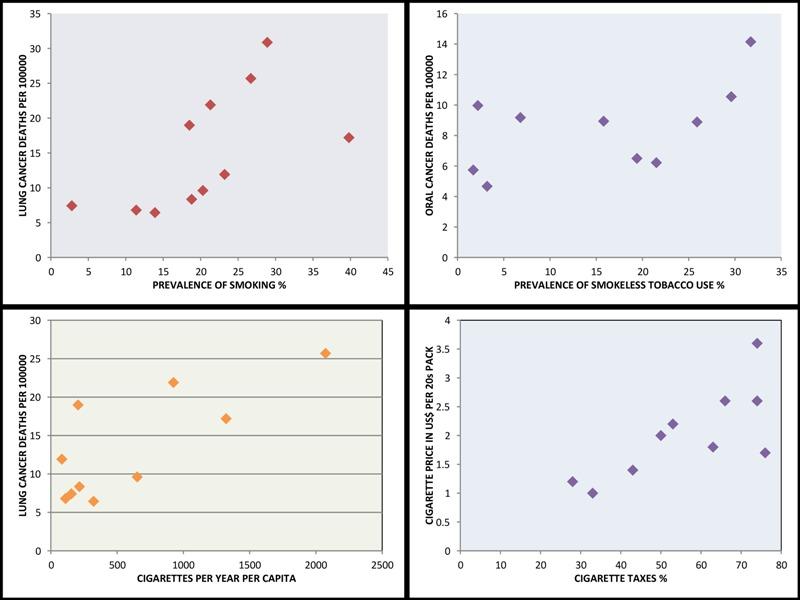Home
Issues
Aims and Scope
Open Access
Editorial Board
Indexing
Why publish with us
Contact us
Instructions to authors (PDF)
Manuscript Types
Manuscript Formatting
How to submit
Preprints
Special Publications & Reprints
Authorship & COI
Principles of Transparency Checklist
Data Policies
Publication Ethics and Publication Malpractice Statement
Correlates of tobacco use and disease burden - an analysis of the World Health Organisation South East Asian Countries
1
Nitte University, Public Health, India
2
District Anti Tobacco Cell, Health & Family Welfare, India
3
High Power Committee, Health & Family Welfare, India
Publication date: 2018-03-01
Tob. Induc. Dis. 2018;16(Suppl 1):A282
KEYWORDS
TOPICS
ABSTRACT
Background:
World Health Organisation´s South-East Asia Region is home to about one fourth of the world's population. Of this, there are about 246 million smokers and 290 million smokeless tobacco users. In addition to the human toll, the effects of tobacco are felt significantly in the economy of a country. The World Bank has declared that, when effects of poverty due to loss of income, spending on tobacco and costs of illness are taken into account, tobacco use is a net loss to an economy.
Methods:
Results:
The Study represented data of 11 Countries of the WHO South East Asia Region. Current smoking prevalence ranged between 2.80% and 39.80% with a mean prevalence of 20.7% (± 9.24). Both prevalence of smoking and number of cigarettes smoked per year per ca-pita in the 11 countries had a positive moderate correlation with the number of deaths per 100000 population due to lung cancer (r= 0.62 & 0.76; P=0.04 & 0.01). Oral Cancer increased with prevalence of smokeless tobacco use (r=0.07; P=0.07).

[Correlates between tobacco use and tobacco burden]
Conclusions:
The study findings suggest that tobacco prevalence, tobacco related deaths and tobacco economics can be correlated with the health profile of countries in the region. These countries show positive correlation between tobacco use and related diseases.
World Health Organisation´s South-East Asia Region is home to about one fourth of the world's population. Of this, there are about 246 million smokers and 290 million smokeless tobacco users. In addition to the human toll, the effects of tobacco are felt significantly in the economy of a country. The World Bank has declared that, when effects of poverty due to loss of income, spending on tobacco and costs of illness are taken into account, tobacco use is a net loss to an economy.
Methods:
- Objective of the study: To determine the correlation of tobacco use with tobacco related disease burden and developmental indicators of South East Asian countries.
- Study method: Secondary data-based Cross-Sectional Study
- Data sources: Data on tobacco prevalence, cancer prevalence, human development index, tobacco economics and poverty indicators during the year 2014-2015 were collected from various sources such as WHO Report on Global Tobacco Epidemic 2015, World Bank data, Tobacco Atlas and World Life Expectancy 2014 reports.
- Data analysis: Data were analyzed using Pearsonn´s Correlation Coefficient on SPSS version 16. Results were considered significant at 95% level of significance.
Results:
The Study represented data of 11 Countries of the WHO South East Asia Region. Current smoking prevalence ranged between 2.80% and 39.80% with a mean prevalence of 20.7% (± 9.24). Both prevalence of smoking and number of cigarettes smoked per year per ca-pita in the 11 countries had a positive moderate correlation with the number of deaths per 100000 population due to lung cancer (r= 0.62 & 0.76; P=0.04 & 0.01). Oral Cancer increased with prevalence of smokeless tobacco use (r=0.07; P=0.07).

[Correlates between tobacco use and tobacco burden]
Conclusions:
The study findings suggest that tobacco prevalence, tobacco related deaths and tobacco economics can be correlated with the health profile of countries in the region. These countries show positive correlation between tobacco use and related diseases.
Share
RELATED ARTICLE
We process personal data collected when visiting the website. The function of obtaining information about users and their behavior is carried out by voluntarily entered information in forms and saving cookies in end devices. Data, including cookies, are used to provide services, improve the user experience and to analyze the traffic in accordance with the Privacy policy. Data are also collected and processed by Google Analytics tool (more).
You can change cookies settings in your browser. Restricted use of cookies in the browser configuration may affect some functionalities of the website.
You can change cookies settings in your browser. Restricted use of cookies in the browser configuration may affect some functionalities of the website.

